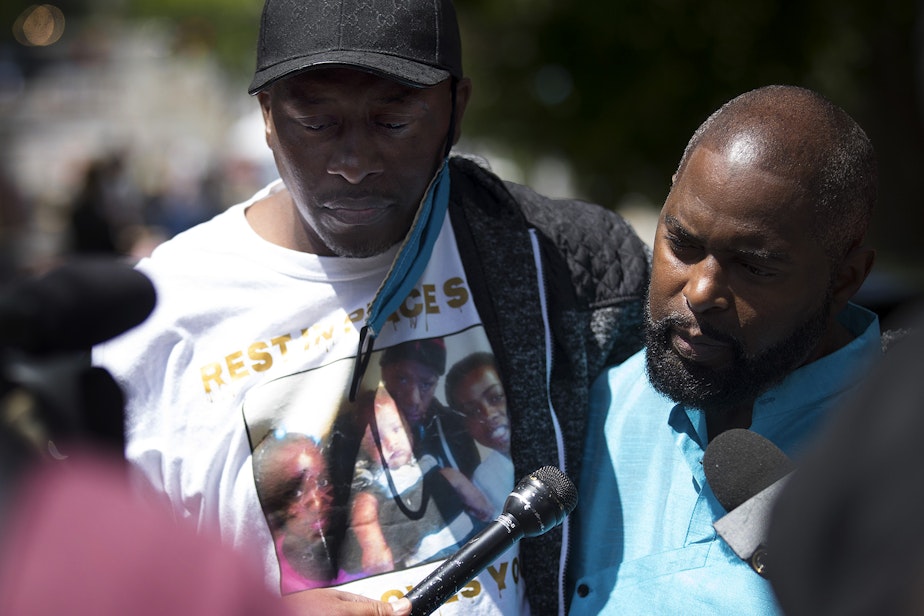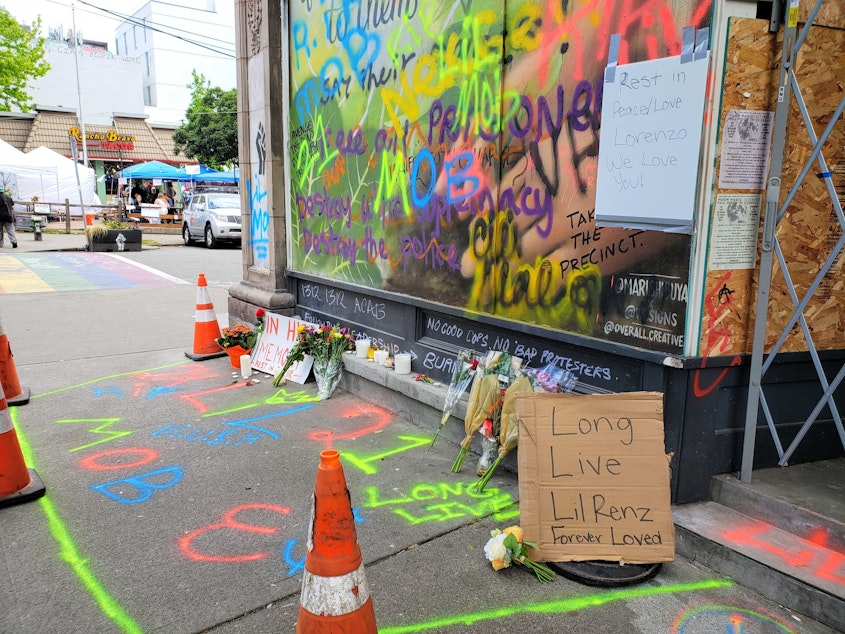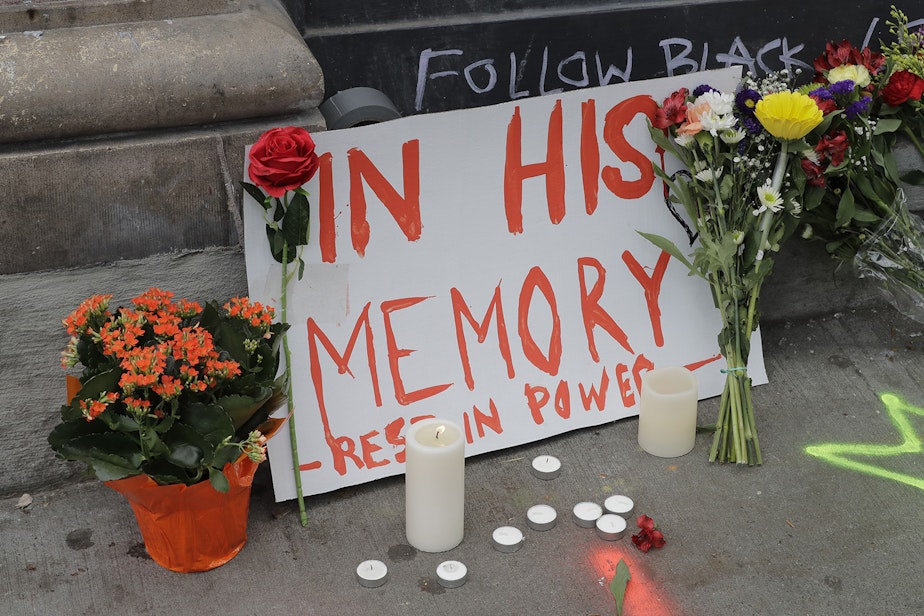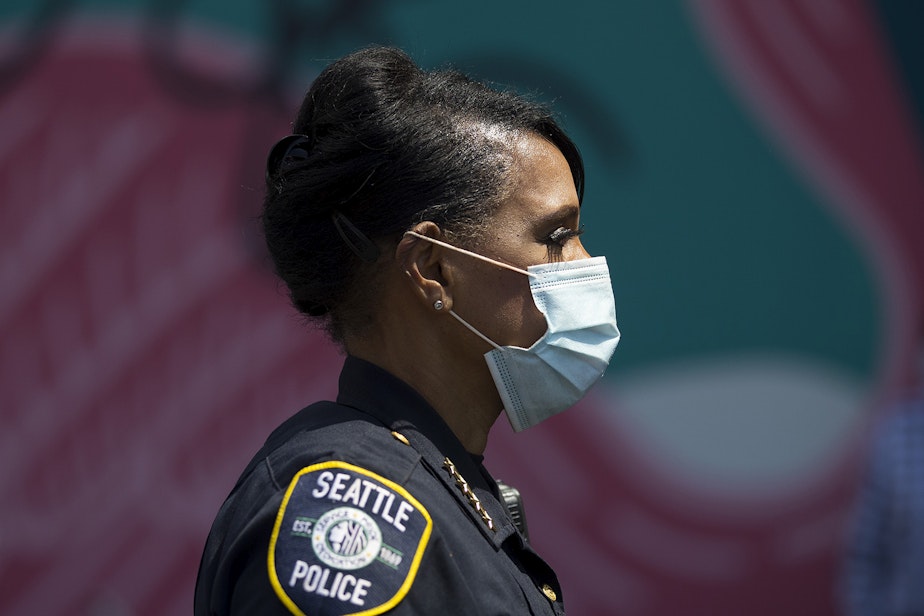Seattle police claimed protesters blocked way to dying man. In fact, miscommunication with Seattle Fire was problem

The mood was festive. It was the night of Juneteenth in the CHOP, the Capitol Hill Occupied Protest zone, and people were celebrating.
And then, at 2:19 a.m., the sound of gunshots.
Horace Lorenzo Anderson Jr., 19, had been shot multiple times. People in the CHOP carried him into a medic tent in this cop-free zone, where volunteers tended to him as they waited for Seattle Fire medics to arrive.
But when police arrived 20 minutes later, to clear the area for an ambulance to get through, Anderson was gone. The street medics had given up waiting and transported him in the back of a pickup truck to Harborview Medical Center.
Anderson was pronounced dead at the hospital. He would be the first to die of a gunshot wound in the CHOP.
Two days later, Seattle Police Chief Carmen Best would say that police officers wanted to reach Anderson, to clear the scene for medics, but were prevented by protesters -- a narrative that would be repeated by Fox News, the conservative national cable news channel.
But protesters did not prevent police from clearing the scene, according to a review of videos, 911 dispatch recordings, and witness testimony from that night. Rather, what slowed emergency responders from reaching Lorenzo Anderson was a miscommunication between Seattle Fire and Seattle Police.
Sponsored
KUOW constructed a timeline of the 26 minutes after the call to 911.
Within moments of the shooting, a dispatcher says that police officers were outside the CHOP, at 12th Avenue and Cherry Street. Fire responders, meanwhile, were a block and a half away from the victim, on Broadway and Pike.
Dispatch calls show that police waited for fire staff to meet them at their location, while fire medics, per policy, waited for police elsewhere to clear the scene for them to move in.
Seattle Police nor Seattle Fire explained what the plan was that night.
Sponsored
KUOW presented the evidence of miscommunication to Chief Best’s communications team, to Seattle Fire, and the police guild.
Best responded through a spokesperson that she stands by her comments that protesters prevented police from reaching the dying man.
MAP: Click on the upper left hand icon for a legend. Click on each icon to read more.
2:19 a.m. Medic tent outside Rancho Bravo Tacos
John Moore, a volunteer medic, dropped to the pavement when he heard gunshots. Moore was face down in the middle of the intersection of 10th and Pine streets, where he was treating someone for an unrelated injury.
Another medic, who asked that KUOW not use her name for fear of retaliation from her employer, was confused by the gunshot sounds. Moments before, a crowd had gathered, and the atmosphere was festive. They were celebrating Juneteenth – a day to commemorate when enslaved people in Texas finally learned they had been freed.
People lit fireworks, she said, and she had just gotten used to the explosions when the gunshots fired. It took her two seconds to realize she was hearing bullets and not pyrotechnics.
After the shots stopped, medic John Moore ran to the aid station outside Rancho Bravo Tacos on Pine Street to grab his designated mass casualty bag.
In came Lorenzo Anderson, carried by the crowd. A table was cleared, and he was placed on it. He had a pulse for about two minutes. When it stopped, they started CPR, Moore said.
Sponsored
Volunteer medics said those on the phone with emergency dispatchers received conflicting information on whether an ambulance, Medic 1, would come into the CHOP to retrieve the patient, or if they would have to transport him themselves to a meeting point. Anderson’s condition made that difficult.
“We saw red lights from the fire department up on Broadway and then, after some time, it became pretty clear the medics weren’t coming,” Moore said.
2:29 a.m. Fire responders sit a block and a half away, waiting for police
At 2:29 a.m., a Medic 1 ambulance was sitting at Broadway and Pike with a fire vehicle, waiting to receive clearance to enter the protest zone from police.
The fire department's "scenes of violence" policy requires firefighters and paramedics to stay two blocks away, and not enter the incident area until police give the okay.
Sponsored
A spokesperson for Seattle Fire said when the "scenes of violence" policy is in effect, Seattle Police responds to the scene and then notifies Seattle Fire when it is safe to respond in. The two departments do not typically meet to coordinate before police go in.
“I want to make sure that we have not been cleared to move into the scene at this point,” an emergency responder says from his radio, from inside a fire department vehicle at about 2:32 a.m.
“That’s negative. Medic 44, we’re still working on it,” a dispatcher says.
“Okay, we have a number of citizens that want us into the location. I just want to make sure we’re not cleared to move into the location,” the emergency responder says.
On Broadway, outside that fire vehicle, a man pleaded with the responders to enter the zone. This man is heard on the background of the dispatch recording, and was captured in a video posted to Twitter.
“You guys could be saving this man’s life right now, but instead of doing that, you’re going to wait here,” he said to the man in the fire vehicle labeled Medic 44. “You guys are that afraid?”
Unbeknownst to these fire responders, police were at 12th and Cherry Street, less than a mile away, waiting for fire to arrive, according to dispatch audio.
"Apparently PD is at 12th and Cherry. Do you want to meet them there and go in with them?" a dispatcher asks Battalion 2, which services the Cal Anderson Park area, two minutes later.
"Have them come to Broadway and (Pike)," Battalion 2 responds.
Radio messages traveled through multiple parties, likely from police, to police dispatcher to fire dispatcher to fire medics. This is common practice, but on this night appears to have created confusion.
“Where are they staging? They’re not with us,” someone on the Seattle Police dispatch channel says at about 2:33 a.m.
“Yeah, we advised them to go to your staging,” a dispatcher responds. “They were staging somewhere else for some reason.”

2:34 a.m. Medic tent outside Rancho Bravo Tacos
Fifteen minutes had passed since the shooting with no sign of emergency responders. Volunteer medics decided they would take Anderson to the hospital themselves, in the back of a pick-up truck.
They hoped an ambulance would be at Pine and Harvard, a meeting point they had discussed previously with Seattle Fire Chief Harold Scoggins and other Seattle Fire personnel, said volunteer medic John Moore. They continued chest compressions as they carried Anderson to the vehicle.
At that moment, the keys for the pickup truck were knocked out of the driver’s hands and onto the ground. The volunteer medics struggled to find them, and in that 30-second lapse, the volunteer medic who asked to remain anonymous decided she would sprint to Seattle Fire Station 25, to plead with responders. She didn't know how long it would take to find the keys. The station was three blocks away.
“You hear this narrative your whole life: If something bad happens, get help, talk to 911. This is what I’m supposed to do, and all I can do,” she said. “You can’t handle something like this on your own when you don’t have the resources available to you.”
The other medics found the car keys shortly after she ran off. They placed Anderson in the bed of the truck, a scene captured by journalist Omari Salisbury. They left at about 2:35 a.m.
Medic Moore, who was in the truck with Anderson, said they drove to the meeting area they had discussed with the fire chief hoping to see an ambulance. And they drove him to the intersection of Broadway and Pine, a meeting point mentioned by dispatchers that night. The ambulance wasn’t there, or anywhere along their path to the hospital.

2:38 a.m. Seattle Fire Station 25
On the opposite side of the protest zone, the volunteer medic arrived at the fire station. She approached a firefighter who was seated in an engine. She told him that Anderson was at 10th and Pine, near Rancho Bravo Tacos. A video posted to social media captured the encounter.
“Where are they?” someone is heard shouting.
Someone else replies: “10th and Pine. 10th and Pine. 10th and Pine.”
The fire truck emerges from the station briefly, before reversing back into the fire station building behind a transparent door.
“I’m doing CPR on a man and have been trying to control his four bullet wounds for the past 10 fucking minutes,” the volunteer medic says to an emergency responder standing on the other side of the door. “I’m on the phone with your dispatch right now. I hope you can make it.”
Meanwhile, at about this same time, police made the call to move in.
“Fire, SPD is preparing to move in from the west,” someone with Seattle Police announced, according to dispatch recording.
“Yeah, we’ve been directed to meet you at 12th and Cherry, is that correct? Yes or no?” someone with Seattle Fire responds.
“Negative, we were told to no longer wait; we are moving in.”
In the background of the video footage captured by the volunteer medic is the sound of police arriving at the western side of the CHOP – the opposite side of where the volunteer medic was.
Sirens wail in the background, and an officer can be heard, shouting on a megaphone, “Please move out of the way so we can get to the victim. All we’re trying to do is get to the victim and provide them aid.”
2:39 a.m. 900 block of East Pine Street
Journalist Omari Salisbury with Converge Media was in the protest zone, broadcasting live with a camera phone as volunteer medics stood by waiting for medical transport for Anderson. Salisbury captured the moment Seattle Police entered the protest zone from Broadway onto Pine, one block west of the protest zone border.
The video shows police officers, holding shields and clad in riot gear, enter into the zone with no impediments or protesters standing in their way. As police neared the crowd of people within the zone, protesters began to shout that Anderson was already gone.
“The victim has left the premises,” Salisbury shouts in the video footage.
“He’s gone,” others are heard yelling in the footage.
The dozen or so officers marched into the CHOP, some with rifles out. Seattle Police bodycam footage captured the officer's vantage point, as they were surrounded by protesters.
"Stop SPD stop!" someone yells from behind the officers. They turn to look.
"The victim is gone," a man in a red shirt explains, as others yell the same around him. Some appear visibly upset — frantic. "They took him to the hospital. They're gone. They're gone in the truck."
The Seattle Police bodycam footage cuts to officers standing outside the CHOP, near their vehicles on Broadway. Protesters chant. Some yell and approach the officers. Others shout profanities. The police officers got in their cars and drove away.
When officers retreated, they may have believed they didn't reach Anderson because the crowd prevented them. In fact, police never reached Anderson because he wasn't there by the time they arrived.
2:45 a.m. Anderson arrives at Harborview Hospital
The volunteer medics transporting Anderson arrived at Harborview Hospital, a mile and a half away from the medic tent inside the CHOP, at 2:45 a.m., according to spokesperson Susan Gregg of UW Medicine.
Anderson was pronounced dead at the hospital shortly after the medics — who performed compressions for about 20 minutes — handed over care.
There was another injured party reported near the protest zone that night, DeJuan Young, who was shot and then transported to Harborview in a personal vehicle after Anderson.

6:25 a.m. Police union president appears on Fox News
Four hours after the shooting in the CHOP, Mike Solan, president of the Seattle Police Officer Guild, spoke with reporters on Fox News. Solan said violence had “besieged” the organized protest zone.
“Early this morning that violence was raw and real, where one of our community members lost their life and police are still not allowed in that area and were prevented (from) providing that police service to the area to locate victims and or render aid,” he said.
Police Chief Carmen Best would say something similar on Monday, June 22, to reporters during a press conference in which the chief called for the dismantling of the protest zone.
“I cannot stand by, not another second, and watch another Black man or anyone really die in our streets while people aggressively thwart the efforts of police and other first responders from rescuing them,” Best said.
Best said that “hasty legislation” by the city council prevented Seattle Police from using tear gas on protesters, which slowed them from reaching Anderson sooner. Best said a life might have been saved if not for these circumstances.
KUOW reached out to Chief Best on Wednesday, a month after the shooting. Best defended her earlier statement that police were blocked from entering:
“Officers entered the CHOP and attempted to locate a shooting victim but were met by a violent crowd that prevented officers safe access to the victims. The Department later learned that the victim had been transported to Harborview.
"The officers' entrance and retreat is captured on video, which I feel speaks for itself."
Mike Solan, the president of the Seattle Police Officers Guild, also defended his statements, which he based on body camera footage released by Seattle Police. He said he hasn't viewed footage that didn't come from Seattle Police.
John Moore, the medic who treated Anderson, while waiting for police to arrive, thought otherwise.
“Gun violence is nothing new in America,” Moore said, a month later, reflecting on that night in the CHOP. “Something that happens in America all the time, happened to be in the area of protest."
It will never be known if Anderson would have survived if police had cleared the scene for Seattle Fire medics to enter sooner. That the 19-year-old died so soon after being shot suggests that he may not have, but in these emergency situations, every minute counts.

